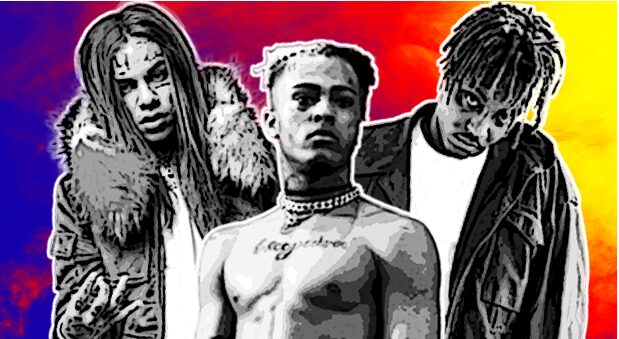Emo rap is a subgenre of hip-hop that emerged in the 2010s, blending elements of emo (short for “emotional”) music with rap. It combines emotionally charged lyrics, often dealing with themes of depression, anxiety, and heartbreak, with the rhythmic delivery and production techniques of rap music. Emo rap artists typically incorporate melodic singing alongside rapping, and their music often features moody, atmospheric instrumentals.
The origins of emo rap can be traced back to the early 2010s, with artists like Lil Peep, XXXTentacion, and Wicca Phase Springs Eternal often cited as pioneers of the genre. These artists drew inspiration from emo bands such as My Chemical Romance, Taking Back Sunday, and Dashboard Confessional, blending the confessional lyrics and introspective themes of emo with the aggressive delivery and beats of hip-hop.
Lil Peep, born Gustav Elijah Åhr, is widely regarded as one of the key figures in popularizing emo rap. His music combined elements of emo, punk, and hip-hop, addressing themes of drug use, depression, and heartache with raw honesty. Songs like “Awful Things” and “Star Shopping” resonated with a generation grappling with mental health issues, and Lil Peep’s unique style helped him amass a dedicated following before his tragic death from a drug overdose in 2017.
XXXTentacion, whose real name was Jahseh Dwayne Ricardo Onfroy, was another influential figure in the emo rap scene. His music was characterized by its emotional intensity and raw vulnerability, tackling topics like depression, suicide, and abuse. XXXTentacion’s debut album, “17,” showcased his ability to blend rap with elements of indie rock and emo, earning critical acclaim and a devoted fanbase. Tragically, he was shot and killed in 2018, leaving behind a complex legacy as one of the most controversial and influential figures in modern rap music.
Wicca Phase Springs Eternal, the project of musician Adam McIlwee, is often credited with bridging the gap between emo and rap music. Formerly a member of the emo band Tigers Jaw, McIlwee began experimenting with hip-hop production and incorporating rap elements into his music under the moniker Wicca Phase Springs Eternal. His early releases, such as the “Secret Boy” EP and the album “Raw and Declawed,” helped define the sound of emo rap and paved the way for future artists in the genre.
As emo rap gained popularity, a new wave of artists emerged, further expanding the boundaries of the genre. Artists like Lil Uzi Vert, Trippie Redd, and Juice WRLD incorporated emo influences into their music, blending catchy melodies with introspective lyrics and trap-influenced production. Juice WRLD, in particular, achieved mainstream success with his emo-inflected rap ballads, earning widespread acclaim for his emotive storytelling and powerful vocal delivery.
The emo rap scene continued to evolve in the late 2010s and early 2020s, with artists like Lil Tracy, Lil Lotus, and 93FEETOFSMOKE pushing the genre in new directions. These artists experimented with a variety of sounds and styles, incorporating elements of punk, pop-punk, and alternative rock into their music while maintaining the confessional lyricism and emotional honesty that defined emo rap.
In recent years, emo rap has become increasingly influential within the broader hip-hop landscape, with artists like Lil Nas X, Machine Gun Kelly, and Travis Barker incorporating emo influences into their music.
Emo rap’s ability to capture the angst and vulnerability of a generation lies in its raw and unfiltered approach to storytelling. Unlike traditional hip-hop, which often focuses on themes of success, wealth, and power, emo rap delves into the struggles and inner turmoil of its artists and listeners. By addressing topics like depression, anxiety, heartbreak, and addiction, emo rap provides a cathartic outlet for individuals grappling with mental health issues and emotional pain.
The genre’s confessional lyricism allows artists to express their deepest thoughts and feelings in a way that resonates with listeners on a profound level. Emo rap songs often feel like personal diary entries, offering a glimpse into the artist’s inner world and inviting listeners to connect with their experiences on an emotional level. This level of vulnerability fosters a sense of empathy and understanding among fans, who often find solace in knowing that they are not alone in their struggles.
Moreover, emo rap’s melodic and atmospheric soundscapes create a mood of introspection, setting the stage for the exploration of complex emotions. The blending of rap with elements of emo, punk, and alternative rock allows artists to draw from a diverse range of influences, resulting in music that feels authentic and relatable to a wide audience.In addition to its emotional resonance, emo rap has also become a platform for addressing important social issues, such as mental health awareness, addiction, and the stigma surrounding emotional vulnerability.
By providing a voice for those who feel marginalized or misunderstood, emo rap has emerged as a powerful and influential force within the hip-hop landscape, shaping the cultural conversation and resonating with listeners around the world.








